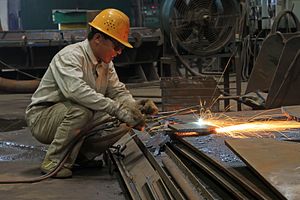China is preemptively moving to blunt the impact its supply-side reforms will have on the labor market. According to Feng Fei, a vice minister in China’s Ministry of Industry and Information Technology, China is setting up a fund worth 100 billion renminbi ($15.3 billion) to assist workers who lose their jobs as a side effect of China’s quest to reduce industrial overcapacity and eliminate “zombie companies.”
At the Central Economic Work Conference last December, China’s top leaders made it clear that 2016 would be the year of “supply-side reform” – namely, reducing the supply glut across a number of industries, from iron to solar panels. The over-capacity – a symptom of the disconnect between China’s state-owned enterprises and market forces – has become a drag on growth for China, while also leading to tensions with other countries who accuse China of selling its excess goods at below cost.
However, cutting industrial capacity will inevitably mean cutting jobs. China has tried to downplay the effects – a study from a Chinese investment bank in January predicted that the restructuring would have only a minor impact on the country’s overall employment. However, that same study admitted that up to 3 million Chinese might lose their jobs to the capacity cuts – and even its optimistic estimate has one million Chinese workers remaining unemployed.
Likewise, Xu Shaoshi, the head of China’s National Development and Reform Commission, predicted that unemployment would rise in provinces that are economically dependent on heavy industry, such as Shanxi and Heilongjiang. But he assured the media that the national and local governments would have policies in place to deal with the coming job losses.
Feng’s remarks on Thursday revealed one such policy: a $15.3 billion fund to help reemploy for those who find themselves out of work as a result of industrial reform. The fund will cover the cost of job training and finding other employment.
Feng acknowledged that China’s emphasis on supply-side reform and streamlining production will inevitably lead to job losses, making it a priority to find new employment for laid-off workers. The government will mainly be concerned with the issue of finding proper placement for workers during the “structural adjustment” period,“because his process will involve workers losing their jobs,” Feng said.
At the same time, Industry and Information Technology Minister Miao Wei told reporters that China has already made a great deal of progress on the overcapacity issue. In the last five years, China “eliminated 91 million tonnes of outdated capacity in the iron industry and 94.8 million tonnes in the steel industry,” People’s Daily reported, citing Miao. China plans to cut steel capacity by an additional 100-150 million tonnes over the next five years as well.

































